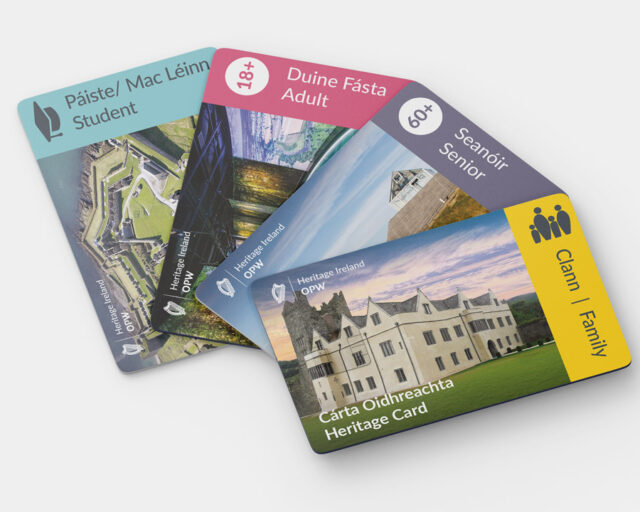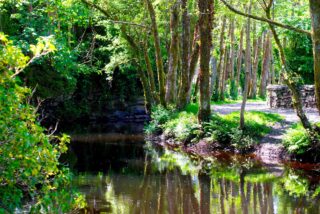
The cream of west Galway’s Gaelic nobility, the O’Flahertys, made Connemara their home for almost four centuries after being expelled by the Anglo-Normans from the rich limestone plains east of Lough Corrib in the thirteenth century. There they had already gained reputation for their seafaring prowess, controlling both Lough’s Corrib and Mask as well as the trading mecca in Galway Bay. This strongly held maritime outlook was one that was to sustain the O’Flahertys well into the sixteenth century and one that was to characterise their often-ferocious nature. A ferociousness best exemplified by the people of Galway who represented the O’Flahertys as “mountainous and wild people”, by whom “they were sometimes robbed of their goods, and killed by those unlearned men”. Galway had grown into a powerful independent city-state, almost completely detached from the rule of both the Dublin and London administrations but feared the “contaminating Irish influence” outside of its stout city walls. A series of restrictive bye-laws soon prevented the Gaelic clans from trading through the port of Galway, so severely reducing the O’Flaherty’s capacity to trade that they would always be at odds with their city-dwelling neighbours. Consequently, they often took the opportunity, whether on land or at sea, to engage in thievery, disorder and mayhem, attacking merchant ships off the coast, hence the famous plea inscribed over the Great West Bridge leading into city, “From the Ferocious O’Flaherties Good Lord Deliver Us”.
Connemara (or Iarchonnacht as it was known) on the other hand, was a land still untouched by English rule and comprised an area that covered approximately a quarter of a million acres, encompassing mountains to the north, the heavily indented Atlantic coastline to the west and south and Lough Corrib to the east. The interior comprised the “fastnesses” much commented on by English writers – wide tracts of bog, woodland, marsh, lakes and rivers, rough mountain grazing and some fertile land. Here the O’Flaherty world flourished, a refuge of ancient customs and traditions virtually cut off from the rest of Ireland by Lough Corrib and Killary Harbour. They ruled supreme as Gaelic warrior lords and depended on the sea for trade, food and transport while the green fields and mountain pastures provided grazing for their herds. By the sixteenth century they had built a network of small castles or tower houses along the Atlantic coastline and further east towards Lough Corrib from where they ran their prosperous little Gaelic kingdom, far out of the reach of English law. English power was confined to the Pale and Ireland was essentially in a state of disunity and fragmented loyalties with no one authority recognised over the entire island. Warfare, cattle-raiding and bloody power struggles were the order of the day. The O’Flaherty’s heyday had begun.
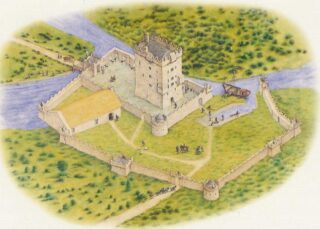
Built in c.1500, Aughnanaure Castle became their main stronghold and the crowning example of the O’Flaherty’s building legacy. Built on a limestone outcrop on the south bank of the Drimneen river the location on water is in keeping with the O’Flaherty tradition of building their tower houses with access to lakes, rivers and coastline; a visible statement of the family’s wealth and status on an important route-way to the Corrib. Here the O’Flaherty family generated wealth under a pastoral economy and used the castle as a means of political control, imposing their firm grip over the local population. They were joined with their allies the O’Malleys, another powerful, seafaring family from further north in Clew Bay, when Dónal an Chogaidh (of the wars) O’Flaherty married the young Grace O’Malley or Granuaile. Their marriage was a fitting one as the two hardy families were equally matched in their traditions, values, reputations and most importantly, their power and influence. Dónal was the elected tánaiste to the senior chieftaincy of all O’Flaherty septs and eventually would become ruler of all Iarchonnacht.
The six-story tower house of Aughnanure soon became the setting for intrigue and double-dealing as a junior member of the clan rose to an unprecedented position of power in the late sixteenth century. Murrough na dtuadh “of the Battle-axes”, Dónal Crón “the Valiant” and Dónal an Chogaidh “of the Wars” were in the late sixteenth century the three most powerful chieftains to emerge from O’Flaherty clan, their adopted titles and prowess in battle marking them out as men of war among both their followers and enemies alike. But it was Murrough O’Flaherty, a formidable chief with big ambitions, known for mounting frequent raids on the English territories around Galway, who submitted to the English and was thusly appointed to the Chieftainship of all the O’Flaherty’s as long as he undertook to “observe the Queen’s peace”. Shockwaves ran through the O’Flaherty clan as one of their own had “joined the Queen of the English”, but more importantly, Murrough was but a minor player in the O’Flaherty hierarchy and not the legitimate chief of the clan. That title belonged to Dónal Crón or “the Valiant” but it does not appear that Murrough’s conscience was ever in question; he was generally content to side with the Crown in return for title and aid in extending his possessions, regardless of the consequences for his kinsmen. But it was Dónal an Chogaidh who had most to lose, his right to the O’Flaherty title quashed, a faint whisper of the tide of change that was to come crashing on Connemara in the not so distant future.
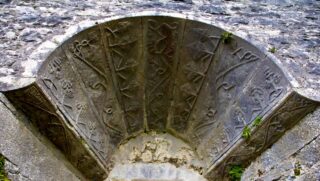
Aughnanure Castle then became the principal seat of Murrough from 1572 and the majority of the standing remains today can be attributed to his efforts to express his newly elevated position of Chieftain of Iarchonnacht. The remaining east wall of the banqueting hall in particular, bears witness to the function and importance of the building. Its windows are richly and elaborately carved with vine leaves and clustering bunches of grapes, as if to attest to the magnificent hospitality of its former proprietors. Murrough’s ferocious character was well demonstrated in the banqueting halls legendary trap-door or “flagstone of treachery”, used to dispose of any unwelcome guests into the river flowing beneath the hall.
For nearly four centuries the O’Flahertys controlled Connemara and maintained an intimate connection with the lake and the sea. They continued with their cattle raids, piracy and petty warfare as an independent warrior clan, unaware of the changes being organised from across the water. But the expansionary and colonial policies of the English Crown impacted on Ireland in the late sixteenth century and finally brought an end to Gaelic rule. In order to survive this turbulent time, the O’Flahertys were forced to take on many roles – warriors, mariners, pirates, and rebels. Roles that have earned them much notoriety in the pages of Irish history. Although they retained their ancient ways, they had lost their power and having been active in the Rebellion of 1641, their lands were confiscated, their territories parcelled out and the era of O’Flaherty rule in Connemra came to an abrupt end. But the fundamental symbol of old O’Flaherty power and dominance over Connemra would forever be Aughnanure Castle. To lose such a magnificent property would be the ultimate defeat, therefore any opportunity to reacquire their lost property was taken with fervour and the ensuing seesaw of its ownership that followed through the proceeding centuries is a testament to their persistence. The ebb and flow of acquisition and loss over the years turned once more to the advantage of the O’Flahertys when a young solicitor from Enniscorthy, Co. Wexford, Peter O’Flaherty, handed the castle over to the State in 1952. A restoration and conservation programme began in the 1960s and in 1974 after two hundred years of lying idle and broken, the doors to the castle were opened once again. Its importance to the area cannot be underestimated and as the most visible surviving physical expression of late medieval cultural activity in Connemara, it’s one that should be treasured forever. Today, many thousands of visitors come to the castle annually to discover the secrets hidden within its walls and walk in the footsteps of the O’Flahertys — a family that played such a significant part in the shaping of Connemara.
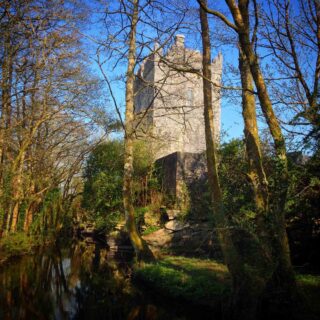
About the Author
Jenny Young holds a BA in Archaeology & Geography and a MA in Landscape Archaeology from NUI Galway. She works at Aughnanure Castle and has developed a passionate and broad interest in medieval Gaelic settlement and society. She is currently undergoing research into the medieval Gaelic lordship of Iarchonnacht for a future publication.


